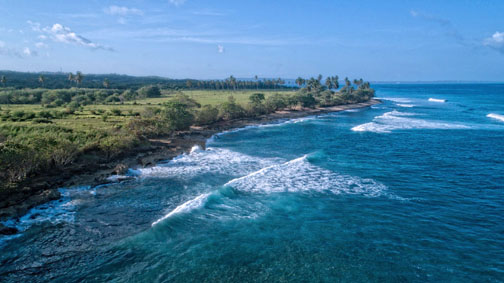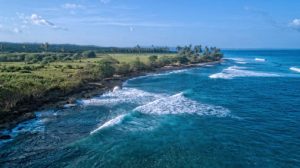Columbus Landing future on hold as court fight heats up


Rich in flora and fauna, the Playuela area is home to wetlands and is in close proximity to zones of ecological and environmental value. (Credit: Campamento Rescate Playuela)
The future of a controversial resort development that got off the ground last year on a prized parcel along the Aguadilla coastline is up in the air as opponents of the project and its developers square off in court.
Opponents of Christopher Columbus Landing Resort recently filed a lawsuit in the Court of First Instance for the district of Aguadilla seeking to invalidate the permit that Caribbean Management Group, Inc., secured from the municipality to commence the initial phase of the project.
Columbus Landing has been in the making for two decades but opposition from the start, economic doldrums and a change in ownership along the way had prevented it from going forward.
Its first phase kicked off last Oct. 30 with construction of an access road to the property.
Work on the road recently ground to a halt and it is not clear when it will resume.
Reinaldo Vincenty, one of three partners in CMG, was not available for comment despite attempts to reach him by phone and by e-mail.
In their lawsuit, opponents claim that CMG failed to secure all the endorsements required for the road and relied on an outdated environmental impact statement to get the Aguadilla municipality’s go ahead.
That statement was approved in 1997 based on considerations that, according to opponents, have changed considerably over the past two decades.
As such, it does not provide “a valid and up-to-date” assessment of the impact of the project in all of its phases.
The lawsuit, which also names the municipality as a defendant, petitions the court to declare the environmental impact statement invalid and to stop all activity and construction in the area until the developers comply with environmental public policy.
“We understand we have a good chance of prevailing,” said Omar Saade Yordán, one of the lawyers representing the Liga Ecológica Puertorriqueña del Noroeste, Inc. and private citizens as plaintiffs.
The controversy
Columbus Landing has been controversial from the very beginning. Opposition stems mainly from concerns over the impact of the project on the environment and the community through increased noise, traffic and garbage.
Rich in flora and fauna, the area is home to wetlands and is in close proximity to zones of ecological and environmental value. In 2008, the National Marine Fisheries Service designated a neighboring area as a “critical habitat” for two coral species. Any construction in the area could compromise these endangered species, opponents claim.
The land to be developed is among a shrinking number of undeveloped parcels left in Puerto Rico. Over the years, as development of the project failed to materialize, it has become a magnet for nature lovers and beachgoers as well as for local and international surfers seeking the thrills of the area’s famous breaks like “El Mix,” Wilderness” and “Wishing Wells.”
No longer the same project
Columbus Landing inspires different visions.
Opponents would like to see the parcel turned into a nature reserve or a site for low-impact eco-tourism while supporters value the project as a an economic opportunity for a struggling island.
Puerto Rico has been in recession for more than a decade, is losing population fast to emigration and faces a staggering $70 billion debt.
In an interview last December, Aguadilla Mayor Carlos Mendez gave his full backing to the project as it would create badly needed jobs and help boost the area’s tourism.
The master plan for Christopher Columbus Landing resort envisioned a grand tourist and residential development spread over the 121-acre, oceanfront property located in Aguadilla’s Playuela sector, about a mile from Rafael Hernández Airport.
But the project that the current developers plan to carry out is not the same the original developers, Koeniger Development Inc., submitted to the government in the late 90s.
(CMG acquired the land from Caribbean Seaside Height Properties Inc., a company that teamed up with Koeniger in the early aughts. The purchase took place in 2006.)
The originally approved site authorization covered a three-story hotel, a 17,000-square-foot casino, a 75,000-square-foot commercial area, and a dozen structures for use as villas, condo, and condo-hotel. None of these residential buildings would be more than four stories high.
The government also conditioned the granting of the site authorization, a permit that requires an environmental impact statement or an environmental assessment, on the developers starting construction within seven to 10 years.
Over the years, the developers submitted various preliminary project proposals or “anteproyectos” but at no time requested a construction permit. (According to a permitting official, these proposals allowed the developers to maintain the site authorization active.)
The current project features a seven-story hotel, two four-story parking structures, and four-story residential buildings. Additionally, there is a casino and a convention center.
The access road, connecting with a narrow local road that runs along Playuela’s residential zone, is “Incompatible” with the one approved in the original authorization, the lawsuit stated.
In view of these changes, the plaintiffs asked the court to paralyze all construction activity until GMC complies with environmental public policy and submits a new statement.
“The Environmental Impact Statement lost its validity in that it no longer reflects the significant environmental impacts of the current project, a flagrant violation of the very purpose behind the preparation of an environmental document,” the lawsuit stated.
Winners and losers
While a court ruling is not expected anytime soon, Saade said plaintiffs are prepared to go all the way to the Puerto Rico Supreme Court if they lose.
A loss for the defendants, unless they appeal, will mean having to get new permits for the project but a recent development could give them a break.
Puerto Rico Gov. Ricardo Rosselló just signed a reform of the permitting process designed to make it more agile and efficient.
The new Permit Process Reform Act creates a unified information system for filing and processing permits and gives the Office of Permits Management (OGPe, by its Spanish acronym) jurisdiction over site authorizations, a permit required for projects that need changes in land classification or zoning.
OGPe retains its function of evaluating and approving environmental statements and assessments but the process will be expedited to take no more than 120 and 180 days, respectively.
Ian Carlo Serna, OGPe executive director, said the developers of Columbus Landing could solicit a new site authorization through his agency.
While the private sector has welcomed the permitting reform, environmental activists have voiced concern over some of the changes. For example, any challenge to an environmental assessment or environmental impact statement will have to wait until after OGPe has granted the permit. OGPe also will not be bound by recommendations made by the Environmental Quality Board or the Department of Environmental and Natural Resources regarding projects.
Aguadilla activists worry the new law might make it easier for the developers of Columbus Landing to get their project back on track.
There is a flip side, however. The new Land Use Plan approved under former Gov. Alejandro Garcia Padilla designated some parcels as urban-free lands or “suelos rusticos.”
This classification entails special protection and, according to Saade, the Columbus Landing site falls in this category.
OGPe’s Cano said this classification does not preclude development but any approval would hinge on the type of project proposed.
Surfrider Foundation
The startup of construction at Columbus Landing last October unleashed animated protests that ended in several arrests and led to the setting up of a protest camp near the access road where volunteers give chats on civil disobedience and provide information to the public.
It also spurred an online petition to stop the project and declare the area a natural reserve. Surfer Magazine, Surfrider Foundation International Surfing Community and 14 other groups were among the petitioners.
To date, close to 24,000 people have signed the appeal.
Recently, Columbus Landing area is drawing more visitors and camping activity is up, according to an activist from the area. He cited reports that the developers are trying to make their project more eco-friendly so it will be more palatable.
“It’s the same project except disguised to look greener,” he said.
Well-known environmentalist Luis Jorge Rivera lamented that the developers couldn’t come up with a world-class eco-tourism project tied to surfing, a major activity in the area, instead of opting for a conventional tourist development.
Still, he recognized that the land in contention is privately owned and its owners have the right to develop it economically.
“But this does not mean they can build what they want,” said Rivera.
“They must comply with the law.”












I don’t understand.
Why don’t environmentalists, most of whom don’t even live year
round or pay taxes in Aguadilla, join forces with Surfrider to fundraise
and purchase the developmental rights to this land outright, at full
market value from the owners/developers? (No one is preventing you
from doing this. No one.) Surfrider can certainly tap into it’s cabal of
rich donors or simply cut back on administrative travel around the
world to come up with the money to buy this land. But before doing
that, Surfrider might want to fix the multitude of ALREADY existing
problems before creating new ones where none yet exist!
There are no income producing mechanisms for job creation in
the area much less ones that give hope to residents in overcoming
a bad economy. And, to be very honest, it’s not exactly like garbage
dumping in forests, beaches, or groundwater contamination from
defective septic tanks, have all been resolved.
Environmentalists are their own worst enemies. When will they learn
that in order to achieve the most meaningful success of their valid
platform, they need to see landowners as someone to work with,
rather than be against? Having the first, antagonistic word always
be “no,” based on something that happened years ago, is
counterproductive. And, as for land owners and developers, you
folks really need to learn the magic of the countersuit!